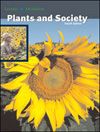 |
1 |  | 
In fungi, masses of threadlike _________branch extensively into a collective mass called a ________. |
|  | A) | a. septa, hyphae |
|  | B) | b. hyphae, mycelium |
|  | C) | c. septa, mycelium |
|  | D) | d. mycelium, septa |
|  | E) | e. fibers, mushroom |
 |
 |
2 |  | 
2. Which of the following describes the group fungi? |
|  | A) | a. Fungi are heterotrophic. |
|  | B) | b. Some fungal cells possess chlorophyll. |
|  | C) | c. Fungi have an absorptive type of nutrition. |
|  | D) | d. all of the above |
|  | E) | e. only a and c |
 |
 |
3 |  | 
3. The fusion of cytoplasm from two cells or gametes |
|  | A) | a. occurs early in the fungi life cycle. |
|  | B) | b. is called plasmogamy. |
|  | C) | c. is followed by karyogamy. |
|  | D) | d. all of the above. |
|  | E) | e. b and c are correct. |
 |
 |
4 |  | 
4. Fungal cell walls are largely composed of ________, a nitrogen-containing polysaccharide, with a few exceptions that possess ________ fibrils. |
|  | A) | a. cellulose, protein |
|  | B) | b. lignin, chitin |
|  | C) | c. chitin, cellulose |
|  | D) | d. matrix, pectin |
|  | E) | e. none of the above |
 |
 |
5 |  | 
5. In the Division Myxomycota, the plasmodium stage is the animal-like feeding stage. |
|  | A) | True |
|  | B) | False |
 |
 |
6 |  | 
6. In the Division Oomycota, ________ form as a result of fertilization, and ________ are motile asexual spores. |
|  | A) | a. teleospores, zoospores |
|  | B) | b. oospores, zoospores |
|  | C) | c. zygospores, sporangiospores |
|  | D) | d. oospheres, antheridia |
|  | E) | e. oogonium, gametangia |
 |
 |
7 |  | 
7. In the Division _______, ascospores are produced within a saclike ascus. |
|  | A) | a. Ascomycota |
|  | B) | b. Deuteromycota |
|  | C) | c. Oomycota |
|  | D) | d. Zygomycota |
|  | E) | e. Myxomycota |
 |
 |
8 |  | 
8. One of the largest living colony of organisms is a basidiomycete in Washington State that covers 1,500 acres. |
|  | A) | True |
|  | B) | False |
 |
 |
9 |  | 
9. Penicillium is placed in a group of fungi called the Fungi Imperfecti. |
|  | A) | True |
|  | B) | False |
 |
 |
10 |  | 
10. Organisms that have both a saprobic and a parasitic lifestyle are known as ectomycorrhizae. |
|  | A) | True |
|  | B) | False |
 |
 |
11 |  | 
11. The mycobionts of vesicular-arbuscular mycorrhizae belong to the Division ________. |
|  | A) | a. Basidiomycota |
|  | B) | b. Ascomycota |
|  | C) | c. Zygomycota |
|  | D) | d. Chytridiomycota |
|  | E) | e. none of the above |
 |
 |
12 |  | 
12. There are currently two mating types of Phytophthora infestans that may cause epidemics of potato blight throughout the world. |
|  | A) | True |
|  | B) | False |
 |
 |
13 |  | 
13. The flask-shaped spermagonia of wheat rust develop on the alternate host, __________. |
|  | A) | a. barberry |
|  | B) | b. wheat |
|  | C) | c. chestnut |
|  | D) | d. potato |
|  | E) | e. tomato |
 |
 |
14 |  | 
14. Lichens are often used as a pollution indicator because they are very sensitive to sulfur dioxide. |
|  | A) | True |
|  | B) | False |
 |
 |
15 |  | 
15. Corn smut fungus overwinters ________. |
|  | A) | a. on apples |
|  | B) | b. on plant debris |
|  | C) | c. in soil |
|  | D) | d. all of the above |
|  | E) | e. b and c are correct |
 |
 |
16 |  | 
16. Secondary products produced by plants in response to bacterial and fungal pathogens are known as __________. |
|  | A) | a. phenolic compounds |
|  | B) | b. phytoalexins |
|  | C) | c. tannins |
|  | D) | d. essential oils |
|  | E) | e. both a and c |
 |
 |
17 |  | 
17. Dutch Elm Disease fungus is carried from infected trees to healthy trees by the elm bark beetle. |
|  | A) | True |
|  | B) | False |
 |
 |
18 |  | 
18. The fungal organism responsible for Sudden Oak Death is closely related to the organism that causes ___________. |
|  | A) | a. late blight of potato |
|  | B) | b. corn smut |
|  | C) | c. wheat rust |
|  | D) | d. Dutch elm disease |
|  | E) | e. dry rot |
 |



 2006 McGraw-Hill Higher Education
2006 McGraw-Hill Higher Education